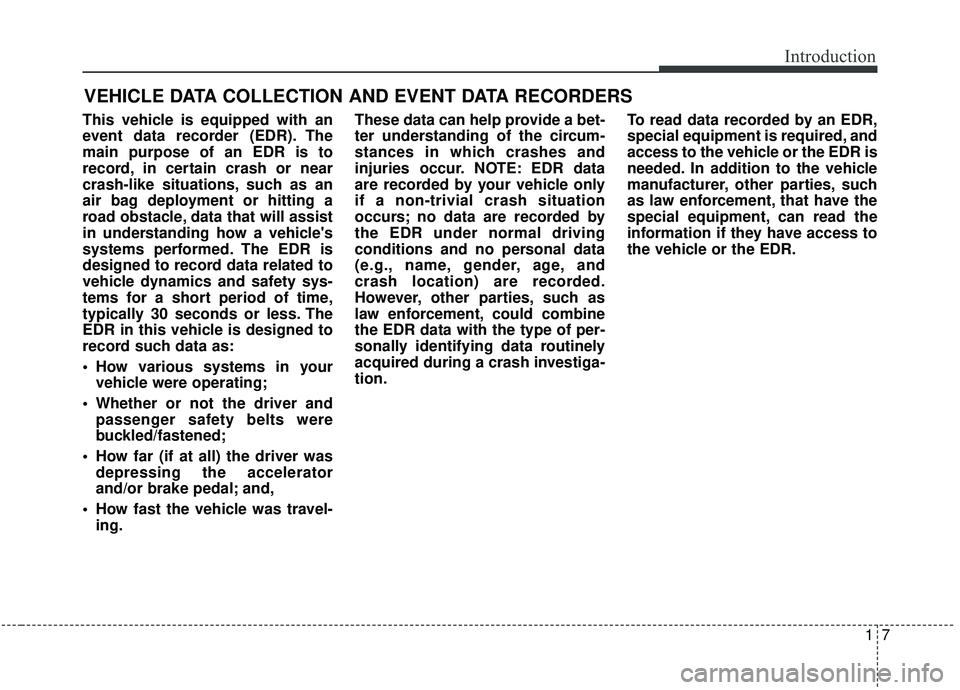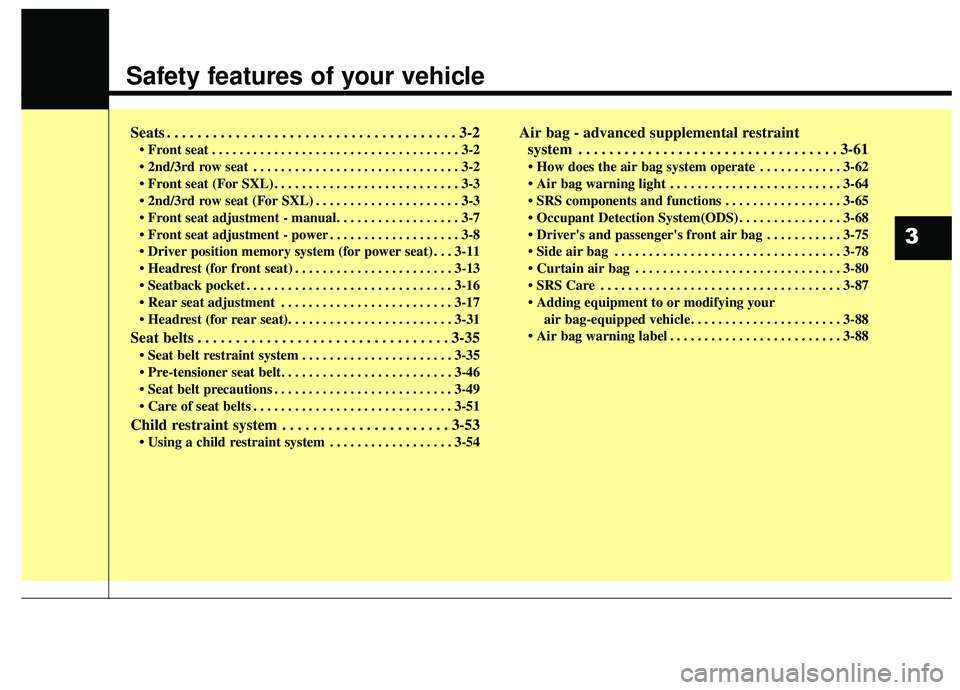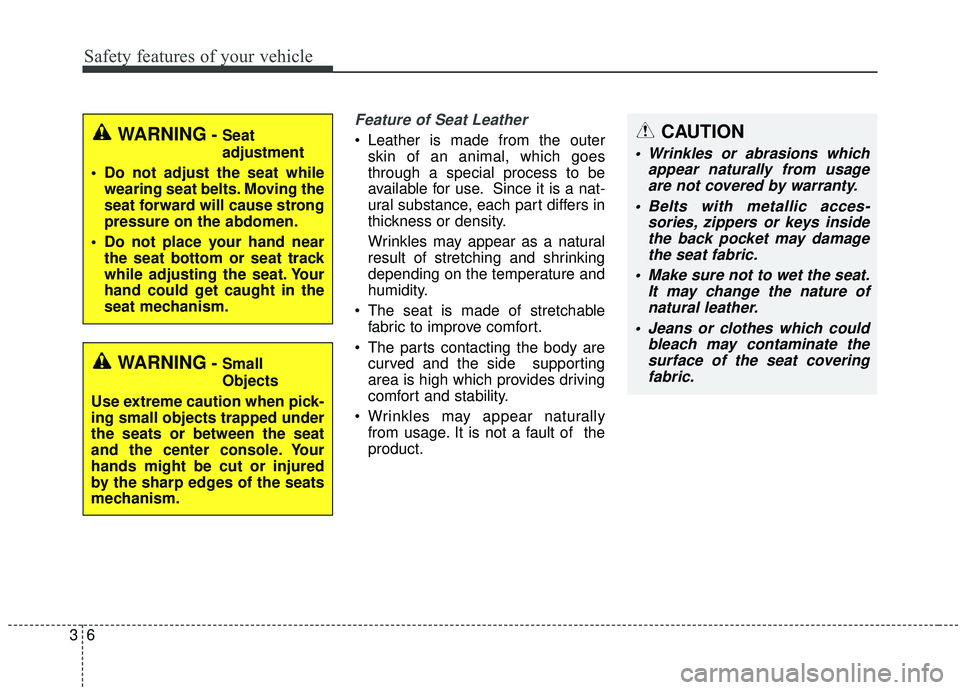Page 10 of 593

17
Introduction
This vehicle is equipped with an
event data recorder (EDR). The
main purpose of an EDR is to
record, in certain crash or near
crash-like situations, such as an
air bag deployment or hitting a
road obstacle, data that will assist
in understanding how a vehicle's
systems performed. The EDR is
designed to record data related to
vehicle dynamics and safety sys-
tems for a short period of time,
typically 30 seconds or less. The
EDR in this vehicle is designed to
record such data as:
How various systems in yourvehicle were operating;
Whether or not the driver and passenger safety belts were
buckled/fastened;
How far (if at all) the driver was depressing the accelerator
and/or brake pedal; and,
How fast the vehicle was travel- ing. These data can help provide a bet-
ter understanding of the circum-
stances in which crashes and
injuries occur. NOTE: EDR data
are recorded by your vehicle only
if a non-trivial crash situation
occurs; no data are recorded by
the EDR under normal driving
conditions and no personal data
(e.g., name, gender, age, and
crash location) are recorded.
However, other parties, such as
law enforcement, could combine
the EDR data with the type of per-
sonally identifying data routinely
acquired during a crash investiga-
tion.
To read data recorded by an EDR,
special equipment is required, and
access to the vehicle or the EDR is
needed. In addition to the vehicle
manufacturer, other parties, such
as law enforcement, that have the
special equipment, can read the
information if they have access to
the vehicle or the EDR.
VEHICLE DATA COLLECTION AND EVENT DATA RECORDERS
Page 17 of 593

Safety features of your vehicle
Seats . . . . . . . . . . . . . . . . . . . . . . . . . . . . . . . . . . . . \
. . 3-2
• Front seat . . . . . . . . . . . . . . . . . . . . . . . . . . . . . . . . . . . . \
3-2
. . . . . . . . . . . . . . . . . . . . . . . . . . . . . . 3-2
. . . . . . . . . . . . . . . . . . . . . . . . . . . 3-3
. . . . . . . . . . . . . . . . . . . . . 3-3
. . . . . . . . . . . . . . . . . . . 3-8
. . . 3-11
. . . . . . . . . . . . . . . . . . . . . . . 3-13
. . . . . . . . . . . . . . . . . . . . . . . . . . . . . . 3-16
. . . . . . . . . . . . . . . . . . . . . . . . . 3-17
Seat belts . . . . . . . . . . . . . . . . . . . . . . . . . . . . . . . . . 3-35
. . . . . . . . . . . . . . . . . . . . . . 3-35
. . . . . . . . . . . . . . . . . . . . . . . . . . 3-49
. . . . . . . . . . . . . . . . . . . . . . . . . . . . . 3-51
Child restraint system . . . . . . . . . . . . . . . . . . . . . . 3-53
. . . . . . . . . . . . . . . . . . 3-54
Air bag - advanced supplemental restraint system . . . . . . . . . . . . . . . . . . . . . . . . . . . . . . . . . . 3-61\
. . . . . . . . . . . . 3-62
. . . . . . . . . . . . . . . . . . . . . . . . . 3-64
. . . . . . . . . . . . . . . . . 3-65
. . . . . . . . . . . . . . . 3-68
. . . . . . . . . . . 3-75
. . . . . . . . . . . . . . . . . . . . . . . . . . . . . . . . . 3-78
. . . . . . . . . . . . . . . . . . . . . . . . . . . . . . 3-80
. . . . . . . . . . . . . . . . . . . . . . . . . . . . . . . . . . . 3-\
87
air bag-equipped vehicle. . . . . . . . . . . . . . . . . . . . . . 3-88
. . . . . . . . . . . . . . . . . . . . . . . . . 3-88
3
Page 20 of 593
Safety features of your vehicle
43
WARNING- Uprightingseat
Do not press the release lever
on a manual seatback without
holding and controlling the
seatback. The seatback will
spring upright possibly impact-
ing you or other passengers.
WARNING- Loose objects
Do not place anything in the dri-
ver's foot well or under the front
seats. Loose objects in the dri-
ver's foot area could interfere
with the operation of the foot
pedals.WARNING- Driver respon-
sibility for passengers
The driver must advise the pas-
senger to keep the seatback in
an upright position whenever
the vehicle is in motion. If a seat
is reclined during an accident,
the occupant's hips may slide
under the lap portion of the seat
belt, applying great force to the
unprotected abdomen.
1KMN3662
WARNING - Seat cushion
Occupants should never sit on
aftermarket seat cushions or sit-
ting cushions.
The passenger's hips may slide
under the lap portion of the seat
belt during an accident or a sud-
den stop.
Page 22 of 593

Safety features of your vehicle
63
Feature of Seat Leather
Leather is made from the outerskin of an animal, which goes
through a special process to be
available for use. Since it is a nat-
ural substance, each part differs in
thickness or density.
Wrinkles may appear as a natural
result of stretching and shrinking
depending on the temperature and
humidity.
The seat is made of stretchable fabric to improve comfort.
The parts contacting the body are curved and the side supporting
area is high which provides driving
comfort and stability.
Wrinkles may appear naturally from usage. It is not a fault of the
product.
WARNING- Small
Objects
Use extreme caution when pick-
ing small objects trapped under
the seats or between the seat
and the center console. Your
hands might be cut or injured
by the sharp edges of the seats
mechanism.
WARNING- Seat
adjustment
Do not adjust the seat while wearing seat belts. Moving the
seat forward will cause strong
pressure on the abdomen.
Do not place your hand near the seat bottom or seat track
while adjusting the seat. Your
hand could get caught in the
seat mechanism.CAUTION
Wrinkles or abrasions which appear naturally from usageare not covered by warranty.
Belts with metallic acces- sories, zippers or keys insidethe back pocket may damagethe seat fabric.
Make sure not to wet the seat. It may change the nature ofnatural leather.
Jeans or clothes which could bleach may contaminate thesurface of the seat coveringfabric.
Page 36 of 593

Safety features of your vehicle
20
3
1.Lift the armrest up , lower the head-
rests to the lowest position and
slide the seat inside. (if necessary).
2.Pull the walk-in strap (1) or recline lever (2) on the 2nd row seat when
the passenger gets in or out of the
3rd row seat.
3.Push the 2nd row seat to forward. After getting out, push the 2nd row
seat to the original position until it
clicks into place.
Make sure that the seat is locked in
place. In the walk-in position, the
front and back sliding function is
not fixed.Leg support (2nd row seat for SXL package)
To use the leg support :
1. Pull the leg support lever up and hold it.
2. Adjust the angle and length of the leg support while holding the leg
support. When using the leg rest,
move the seat to the inner position,
and then toward the back. If the seat
is not moved far back, it may come
in contact with the first row seat.
3. Release the lever and make sure the leg support is locked in place.
Folding the rear seat
The rear seatbacks can be folded to
facilitate carrying long items or to
increase the luggage capacity of the
vehicle.
OYP034294N
WARNING
Never attempt to adjust the 2nd
row seat while the vehicle is
moving or the seat is occupied
as the seat may suddenly move
and cause the passenger on the
seat to be injured.
WARNING - Folded down
seatback
Never allow passengers sit on
top of the folded down seatback
while the vehicle is moving. This
is not a proper seating position
and no seat belts are available
for use.
This could result in serious
injury or death in case of an
accident or sudden stop.
Page 37 of 593
321
Safety features of your vehicle
To fold down the rear seatback
1. Insert the rear seat belt buckle inthe pocket between the rear seat-
back and cushion, and insert the
rear seat belt webbing in the guide
to prevent the seat belt from being
damaged.
2. Set the front seatback to the upright position and if necessary,
slide the front seat forward.
3. Lower the rear headrests to the lowest position.
OYP034267N
OYP034212N
■2nd row center seat (for 8 passenger vehicle)
■3rd row seat
WARNING- Objects
Objects carried on the folded
down seatback should not
extend higher than the top of
the front seatbacks. This could
allow cargo to slide forward and
cause injury or damage during
sudden stops.
OYP034214N
Page 38 of 593
Safety features of your vehicle
22
3
4. Pull on the seatback folding lever
or strap, then fold the seat toward
the front of the vehicle. When you
return the seatback to its upright
position, always be sure it has
locked into position by pushing on
the top of the seatback.
5. To use the rear seat, lift and pull the seatback backward by pulling
on the folding lever or strap.
Pull the seatback firmly until it
clicks into place. Make sure the
seatback is locked in place.
6. Return the rear seat belt to the proper position.
Removing the tumble seat
(for 8 passenger vehicle)
1. Insert the seat belt in the belt assembly cover.
2. Insert the seat belt buckle in the seat cushion pocket.
OYP034216NOYP034218N
OYP037219N
■2nd row seat ■2nd row center seat (for 8 passenger vehicle)
OYP034220N
OYP034267N
Page 40 of 593
Safety features of your vehicle
24
3
Installing the tumble seat
(for 8 passenger vehicle)
1. Put the front anchor strikers along the front anchors on the floor.
2. Insert two front anchor strikers into the front anchors. 3. Lift the rear portion of the seat
cushion then push down firmly to
lock the catches into the rear
anchors until an audible “click” is
heard. 4.Make sure the green mark on the
rear seat cushion frame is visible
and the catches are locked in posi-
tion by moving the seat forward
and backward or lifting the front
portion of the seat. If the green
mark is invisible and the seat
moves, it is not locked properly.
5.Pull up the seatback recline strap.
6.Lift and push the seatback back- ward firmly until it clicks into place.
Make sure the seatback is locked
in place.
7.Return the seat belt to the proper position.
OYP034228N
OYP034225NOYP034232N